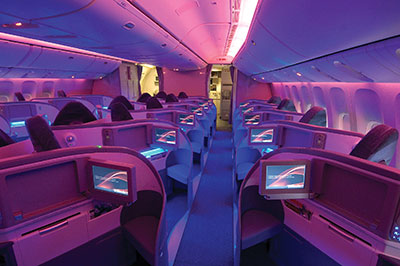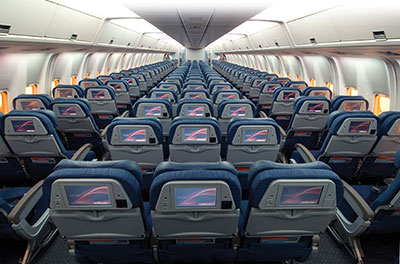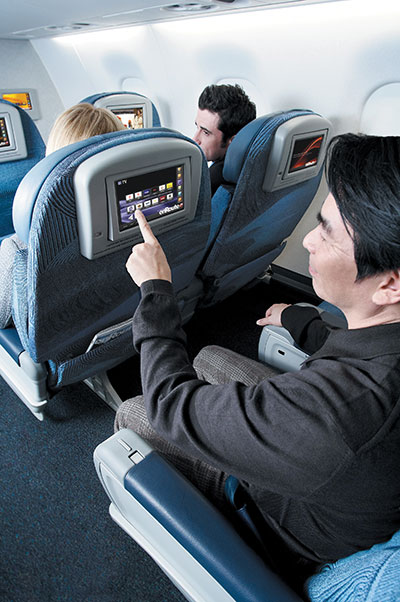
Features
Operations
Now that’s entertainment!
On a cold, windy morning in December 1903, Orville Wright soared across the sands of Kill Devils Hills, North Carolina, completing the first short-haul flight.
January 10, 2014 By Paul Dixon
On a cold, windy morning in December 1903, Orville Wright soared across the sands of Kill Devils Hills, North Carolina, completing the first short-haul flight. On the same day a year before, Marconi had successfully transmitted his first signal across the Atlantic. Moving pictures were little more than a sideshow curiosity and the candlestick telephone was cutting-edge technology for the wealthy few who could afford a telephone in their home.
 |
|
| Air Canada’s 777 features a 12-inch screen with up to 150 movies available on all international routes. Photo: Air Canada
|
In the beginning, the airplane itself was the entertainment, but people quickly began looking for other diversions aloft. In 1921, brave souls attending Chicago’s Pageant of Progress had the opportunity to view an 11-minute movie while being flown over the Windy City. The first commercial airline to show in-flight movies was Britain’s Imperial Airways in 1925, featuring The Lost World for passengers on their London to Paris route. During its 14-month tenure in the 1930s, passengers on the Hindenburg could while away the two-and-a-half-day Atlantic crossing between the piano lounge (a custom-built aluminum piano), dining room, smoking lounge or bar when not in their staterooms. Pan Am’s Clipper service on the San Francisco-Hong Kong route took six days on the Clipper flying boats.
In the post-war era, as air travel became more affordable, the notion of in-flight entertainment was hampered by the size and weight of movie projectors, and more importantly, the noise level from piston engines. Jet aircraft entered commercial service in the late 1950s, introducing longer flights and gradually taking over on long-haul routes and the “jet-set” was born. The introduction of the jet engine meant aircraft doubled passenger loads while cutting transit times in half. Coincidentally, was the development of a 16 mm film system that could easily be fitted on an aircraft, but more importantly the invention of personal headsets that helped minimize the noise. TWA was the first airline to offer in-flight movies with this system, with the movie projected on a single screen on the bulkhead at the front of the passenger cabin. The 16 mm systems were bulky, were capable of playing only a single movie, were prone to breakdown and required ground technicians to maintain the equipment and change the reels at the end of each flight.
The 1970s saw the introduction of the 8 mm film projection system, which could be managed by the cabin crew and was allowed for multiple TV programs and movies. At the same time, audio entertainment systems were introduced and Braniff Airlines went a step further by offering Atari video games. In the 1980s, a new generation of wide-bodied commercial jets took advantage of the cutting-edge technology of the day, CRT projectors that used videocassettes or LaserDiscs. The big breakthrough in the ’80s was the introduction of LCD technology, which enabled the first in-seat video on-demand system. Northwest Airlines was the first carrier to offer individual audio-and-video-on-demand (AVOD), with a whopping 2.7-inch screen, in a trial on its 747 fleet in 1989. Public response was overwhelmingly positive and in-flight entertainment (IFE) as we know it today was gaining momentum.
Moving into the 1990s, the first noise-cancelling headphones were introduced. In 1991, Virgin Atlantic was the first airline to offer seatback video to all passengers across its fleet and then, in 1996, Delta Airlines premiered live television on a B767, offering coverage of the Atlanta Olympic Games. In the same year, Delta was the first airline to install in-seat power outlets on all of its aircraft. In 1997, Swissair was the first to offer interactive video-on-demand on its entire aircraft. As we crossed into the new millennium, JetBlue introduced a live in-flight satellite feed to all classes of passengers across its fleet. In 2010, flydubai became the first airline with an imbedded fibre-optic IFE system.
Finding ways to raise the bar
As IFE systems became more sophisticated and were capable of delivering a wider range of audio and video entertainment, customer expectations kept pace, putting greater pressure on airlines to meet those expectations. The 1990s saw more and more attention focused on the interiors of aircraft and especially the design of the seats in order to maximize the experience for each passenger. New aircraft came equipped with the latest systems, while airlines were faced with the decision of whether or not to update existing aircraft, when it could cost as much as $5 million to upgrade the interior and the seats of a larger aircraft. Safety also became a huge concern, with the miles of wiring required to provide individual connections to each separate screen in an aircraft, a concern that was underscored with the crash of Swissair 111 in 1998 off the coast of Nova Scotia, the result of an on-board fire that started in the entertainment system.
 |
|
| Air Canada’s inflight entertainment system features some 600 hours of on-demand entertainment including TV shows, movies, music albums and satellite radio. Photo: Air Canada
|
As IFE systems were growing during the 1980s and ’90s, a ground-based communications phenomenon was changing the way we live – the cellular phone. In the 1980s, Airfone service on airliners, based on radiophone technology, was available at a premium price – about $7 a minute, a rate that limited use to a very few. As land-based cell phone usage grew exponentially, regulators were firm in prohibiting cell phone use on aircraft – on the ground and in the sky. The threat of interference to aircraft navigation systems and other electrical components was long seen as the main reason, with edicts from the Federal Aviation Administration (FAA) and the European Aviation Safety Agency (EASA). While there were legitimate concerns about electrical interference that researchers worked diligently to allay, the real reason for the ban on cellphone usage in aircraft is the potential impact on ground-based cellular networks from airborne users.
Cell networks in the 1980s and ’90s were designed for ground-based users. Cells can cover up to 20 square miles, depending on population density and geography. In urban areas, separate layers of microcells provide more capacity and in-building penetration. Micro-cells or Pico cells are used in areas of extremely high demand or where physical barriers interfere with radio signals, such as in underground malls, subway systems, etc. Pico cells generally have a maximum coverage area of 200 metres.
All three types of cells operate on the same principle, based on network configuration. Each individual cell is configured with its neighbouring cells so that mobile phones can be handed off to the next cell as a user moves through an area, whether users are walking through a busy shopping mall or driving down a highway. The problem with allowing passengers on commercial airliners to use their cellphones while the aircraft is in flight is twofold: firstly, the cell antennas are not omni-directional, they are designed for a two-dimensional environment which does not include sending or receiving signals in the sky; and secondly, the cellphone systems are designed to switch mobile callers moving at a pedestrian’s pace or a relatively small number of callers moving at highway speeds, not a large number of callers moving at jet speed. Even a single commercial jet flying over a small city could wreak havoc on the computer switching required to hand off calls. Call flooding on individual cell sites and the load from trying to manage hand-offs could result in a system lockup or failure.
In 2005, WestJet introduced real-time television on its 737-700 and -800 fleet. The system utilized the Bell TV satellite system and offered a selection of channels similar to a basic home cable package. Air Canada raised the ante in 2006 by embarking on a $300-million multi-year project to replace the interiors and IFE on all of its aircraft. Project XM-Extreme Makeover resulted in new cabins for all classes of passengers on all aircraft, with new and expanded entertainment options, including larger LCC touchscreens on all seats, interactive games and XM radio. More importantly than simply providing content, the upgrade also saw USB ports installed at each seat and 120-volt AC plugs in each seat row, enabling passengers to charge their own PEDs.
Emirates Airline took the great leap forward in 2007 by being the first airline to allow passengers to use cellphones on its planes. The airline’s system, supplied by AeroMobile, allowed passengers to make and receive phone calls and text messages while at cruising altitude (note the reference to “cruising altitude”). Following Emirates’ lead, a number of airlines around the world began offering varying degrees of Internet connectivity to passengers in flight. Onboard communications were routed through satellite connections to terrestrial connections, allowing passengers access to the web and e-mail. Then the game changed again, when Apple introduced the iPhone in 2007, followed by the iPad in 2010, redefining the concept of personal communications. However, regulators in much of the world were holding fast on restricting the use of cellphones in commercial aircraft.
The wireless wavelength
Wireless traffic is routed through a Pico cell or series of Pico cells, depending on the size of the aircraft, to a central controller. A satellite connection provides Internet access and cell service. The cost of installing the satellite antenna and Pico cell technology is reportedly $100,000 per aircraft, a far cry from the $5 million to replace the interior of a single large aircraft. In the summer of 2013, Air Canada’s new budget carrier, Rouge, began offering streaming media to passengers by means of an app for Apple and PC-based PEDs and laptops for passengers on all of its B767 and A319 aircraft. Passengers could use their own devices and pay a small fee or rent an iPad from the airline. Currently, Android and other operating systems are not part of the system, though Air Canada advises it is working to make the system more inclusive.
The challenge for airlines streaming media content to passengers’ personal PEDs is the fear that copyright material may possibly be retained by the customer for future use. The encryption technology in Air Canada’s app prevents passengers from retaining the material on their device. This fear is underscored by a $250-million suit filed by Sony Music against United Airlines in October 2013 as reported by The Hollywood Reporter. Sony claims United Airlines had been “duplicating” copyrighted recordings and music videos, installing the allegedly pirated copies on servers located on-board their fleets of aircraft, and using the duplicated music as part of its “interactive, on-demand” in-flight entertainment available to passengers. Air Canada claims to be the first airline to offer this extra level of digital copyright security.
In the summer of 2013, the FAA and EASA relaxed the rules about the use of electronic devices during flights, allowing devices to be used in “aircraft mode” during takeoff and landing. This means that carriers would be allowed to let passengers use smartphones, tablets and e-book readers from gate to gate, but Internet connections will be prohibited below 10,000 feet. Cellular voice calls would remain banned. In October 2013, U.S. Federal Communications Commission Chairman Tom Wheeler voiced the opinion that it was time to relax regulations on the use of cellphones on aircraft, which ignited a firestorm of outrage from people who are not willing to be trapped on an airplane beside Mr. “Look at me, I’ve got a cellphone.”
Unions representing cabin crew for U.S. airlines have vigorously opposed cellphone use on airplanes for years and they have been joined at this time by a barrage of editorials, letters to the editor and an avalanche of e-mails to the FCC. It would be some time before approval would be granted as individual airlines would be required to demonstrate that their aircraft would not be affected by on-board electronic devices, and even then the FCC is required to conduct a series of public consultations. In Canada, the airlines have chosen to take a wait-and-see approach. There is nothing preventing Air Canada and WestJet from making a similar application to Transport Canada, but both are holding off at this time. Robert Palmer, WestJet’s manager of public relations, told Wings, “with respect to ground-to-air connectivity, we are examining the most recent developments on this front which are changing rapidly. No decisions have been made.”
Beyond the signal perspective
There’s more to wireless on-board than simply opening the tap and letting the signal flow. Closed-loop systems, where the signal feeds the seatback screen or the passenger’s personal PED, give the airline an element of control over what happens, beyond simply supplying entertainment. The opportunity for passengers to purchase items through the screen rather than wait for a trolley to be rolled up and down the aisle can boost revenues. Flight attendants equipped with a PED would have more information available to them at their fingertips about individual passengers and would be able to access that information from anywhere on the aircraft. Ryanair’s never-shy CEO Michael O’Leary has been quoted as saying he hopes to develop an app that would allow passengers to gamble or watch erotic movies on their PEDs on a pay-per-view basis, defending himself by saying that since hotels do it, why shouldn’t his airline?
 |
|
| The airliner of the future may well offer only a satellite communications link, allowing passengers to use their own device to connect with the airline. For now, however, providing passengers with a wide selection of entertainment options remains a key selling point. Photo: Air Canada
|
Based on today’s technology, the next step for airlines would be offering full broadband connectivity. Panasonic, one of the major players in IFE, talks about connecting the pleasure of flying with the business of flying – the airline is connected with the passenger for the duration (and beyond) and at the same time the aircraft is connected with the airline in real time. From the airline’s perspective, obtaining real-time credit card authorization should effectively end instances of fraud. Then there’s the ability of the airline to offer an online concierge service, referring the passenger to hotels, rental cars and other incidentals that can increase ancillary revenues.
One of the biggest obstacles to offering wide-open broadband and all it promises to passengers is the reality that all PEDs are not created equal. The challenge for the WiFi provider is meeting the connectivity needs of the wide range of devices in the marketplace. Once that has been addressed, the next step is to increase the bandwidth to a level the public expects. The airliner of the future may well not have any native IFE system other than the satellite communications link, allowing passengers to use their own device to connect with the airline and stay connected from the moment they buy their ticket, through every step of the trip itself and continuing on to their destination.
The oldest question in transportation just might be, “Are we there yet?” and that’s a difficult question to answer in this case. The reason is simple: we really don’t know how far we’re heading or what connectivity options will exist if we ever got there. One thing is for certain, however: whatever the future holds in the world of IFE, it’s certainly going to be an entertaining ride.